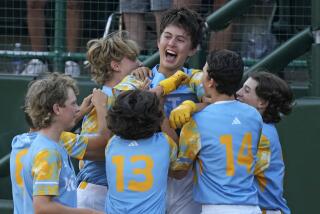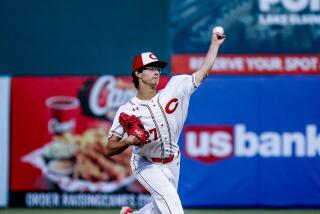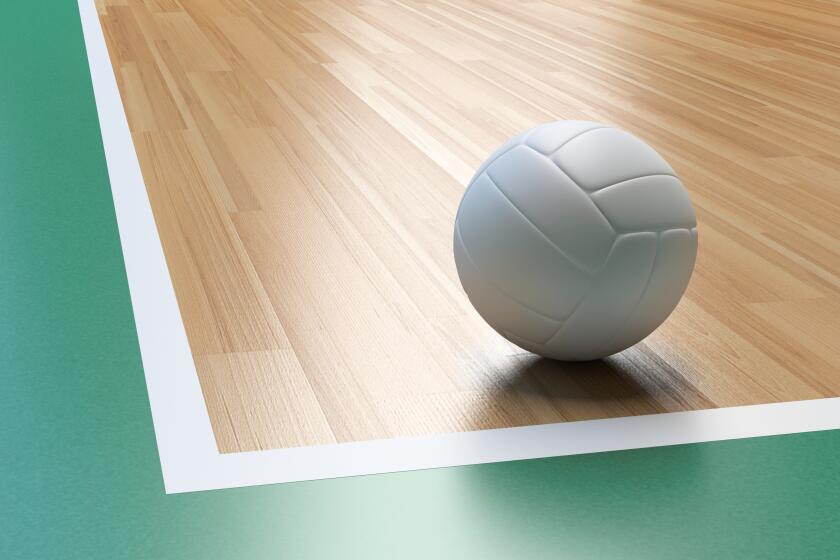Legion Ball : Program Provides the Gateway to the Pros for Many of Today’s Stars
Tony Diaz remembers with a laugh how he happened to be recruited by Brigham Young University in 1976.
Then a catcher on Santa Monica’s American Legion baseball team, Diaz was being interviewed by a Utah newspaperman after his selection as most inspirational player in the regional championships in Salt Lake City.
“He asked me what I wanted to do next and I said I wanted to go to BYU,” recalled Diaz. “Actually, I meant I just wanted to go to the campus to visit a girlfriend, but he thought I meant I wanted to attend BYU.”
Diaz, now the baseball coach at Oxnard High School, said publication of that misinterpretation was the reason he was recruited by BYU, where he played for two years and coached the junior varsity for two more.
‘A Big Difference’
“I had played baseball in California my entire life. BYU had never heard of me. And they probably wouldn’t have if it wasn’t for Legion baseball.
“It made a big difference for me.”
Since its inception July 17, 1925, in Millbank, S. D., American Legion baseball, now 2,600 teams strong nationally, has made a big difference to many of the boys of summer.
“We give kids a chance to continue playing and developing,” said Mel Swerdling, commissioner of four American Legion districts, including the Westside, San Fernando Valley and the San Gabriel Valley. “The season or two that they spend with us could be the difference between continuing their baseball careers at a higher level or having it end.”
Swerdling estimates 75% of current major leaguers have played Legion baseball.
17 Angels, 18 Dodgers
Ray McKinstry, commissioner of California’s largest district, the 19th, which includes the South Bay and Long Beach, put the numbers into sharper focus, saying that last year he counted 17 California Angels and 18 Dodgers who had played Legion baseball.
The list of local Legion alumni reads like a “Who’s Who” of baseball.
San Diego’s Tony Gwynn, the 1984 National League batting champ, and younger brother Chris, now in the Dodger organization, both Long Beach Poly graduates, played Legion ball as did Bobby Grich of the Angels (Long Beach Wilson).
So did pitcher Scott McGregor of the Baltimore Orioles and slugger George Brett of the Kansas City Royals, both of El Segundo High, and Tim Leary of the Milwaukee Brewers pitched for Santa Monica’s 1976 world championship team.
The San Fernando Valley, a hotbed of Legion ball, produced Doug DeCinces of the Angels (Monroe High), Robin Yount of the Brewers, the 1982 American League most valuable player (Taft); the Royals’ Bret Saberhagen, the 1985 Cy Young Award winner (Cleveland); Don Drysdale (Van Nuys), Tim Foli (Notre Dame), Rick Dempsey (Crespi), Biff Pocoroba (Canoga Park) and many others.
“American Legion baseball instills the kids with a sense a sportsmanship and helps them learn for life,” said McKinstry, 75, commander of Peterson Post in Long Beach for 31 years and commissioner since 1971. “And they all realize that a lot of kids have gone on to play in college or in the major leagues.”
The Legion’s No. 1 selling point is its history of producing major leaguers, according to Bill Viverto, who coached the West Covina team for nine years and led it to a third-place finish in the World Series last year.
“In this area, Legion ball is something the kids all look forward to,” he said. “It has such a great tradition that as they progress through Pony League, they envision themselves playing.”
DeCinces: ‘Big Honor’
Angels third baseman DeCinces concurs. He said it was a “big honor” to play Legion ball.
“My first year, I was a 10th-grader and it was really neat to play with older guys. Legion teams were made up of the high-class players from high school, so it was a step up.”
DeCinces rates Legion ball the most competitive of the three summer leagues he played in, which included Connie Mack and a Colt team where he teamed with Dwight Evans, now of the Boston Red Sox.
“As you stepped into American Legion, you had to improve to compete at that higher level,” DeCinces said. “If you couldn’t compete there, you wouldn’t be able to at the next level.
“American Legion baseball was a definite vehicle to further my career as a professional baseball player.”
Scout Spotted Grich
Scouts and college coaches pack the bleachers at Legion games throughout the area, hoping to spot a potential phenomenon they missed during the high school season, according to Viverto.
That’s what happened to Grich, the Angels second baseman, whose first exposure to a big league scout came at the Legion state tournament in Yountville in 1966.
“A scout with Baltimore came up to me and gave me his card and said he was going to tell the club’s scouts in Southern California to watch me next year as a senior,” Grich said. “And next June the Orioles selected me in the first round (the 18th pick) of the draft.”
Mark Razook, who played for Viverto at West Covina last season, was overlooked by pro scouts and college recruiters during his high school career at South Hills. But as the recruiters watched him throughout the summer, Viverto said their “eyes got bigger and bigger.”
Razook was offered a four-year scholarship to Cal State Fullerton, where he was the starting shortstop, batting .295 and with a .934 fielding percentage.
“If I wasn’t playing Legion ball, I wouldn’t be where I’m at now,” said Razook, now playing in a summer league for the Humboldt Crabs in Arcata near Eureka. “I would’ve gone to a junior college and tried to get drafted out of there.”
The competition of Legion ball brought out his talents more than the high school season did, Razook said.
“In high school, each team has two or three standouts,” Razook said. “But in American Legion, there are nine quality players on each team.”
If the program’s history is reason No. 1 for its success, then the way Legion ball is organized is No. 1A.
Players are either asked to join a team based on their performance during the high school season or must go through a tryout.
“It’s like signing and playing in the minor leagues,” Viverto said.
‘Better Brand of Baseball’
And any player who isn’t 19 before Aug. 1 of the current season is eligible. That means that even a player with a year of college experience is eligible for a spot on the 18-man roster.
“It (Legion) was a better brand of baseball,” said McGregor, who pitched for El Segundo in 1970-71 and the first part of the 1972 season before signing with the New York Yankees.
“You had to go nine innings instead of just seven, which helped me. And people put teams together a little more carefully than they did for the regular school year and someone a year out of high school could play. The competition was at a higher level.”
Leary echoed those opinions.
“We had such a good team that we dominated our league. But we had to beat West Covina (a 2-1 victory) to get out of the area, and we had to beat Mike Boddicker (now with the Orioles) 1-0 in 10 innings in the second game of the World Series.”
Leary believes the exposure helped propel him into the big leagues. After consecutive trips to the Legion World Series in 1976 and ‘77, the New York Mets drafted him in 1979.
“Legion ball was probably the most fun I’ve ever had playing baseball,” Leary said.
Diaz still counts winning the national title his biggest thrill.
“We had to get up early for public workouts in front of 4,000 people when we got to the World Series,” Diaz said. “God, back at Santa Monica we were lucky if we had 10 people watching the games.
“We had to deal with reporters and we were in the spotlight. For that brief moment, we felt like professionals.”
But Diaz, in a more somber tone, notes that those days of his Legion glory are gone.
Legion’s Glory Gone?
Some feel that the Legion’s glory days are also gone.
The American Legion no longer has a stranglehold on summer baseball. Summer leagues such as Connie Mack and Babe Ruth have sprouted as quickly as weeds in springtime.
McKinstry said Southern California has too many leagues, all vying for the best players. And when the talent is spread thinly, it weakens all the leagues.
“The American Legion is a fine place for kids to play, but the caliber of talent and competition is not what it was 10 years ago,” said Larry Himes, the Angels scouting director. “It’s diluted and that’s because there are more leagues than there used to be.”
In fact, Himes said that most Legion games, with the exception of the state and national playoffs, aren’t scouted intensely because Legion ball doesn’t start until after the June draft.
Ben Wade, Dodger scouting director, said Legion ball is more important in other parts of the country because there aren’t distractions like the beach.
But Swerdling resists any talk that Legion baseball has lost its luster.
“We’re growing and getting stronger,” he said. “The 20th District (the San Fernando Valley) will expand next year from 17 to 21 teams to become the largest district in the state.”
When someone suggests the caliber of talent has fallen, Swerdling points to 1984 as a red-banner year in the 20th District. Cory Snyder of Canyon High, Sid Akins of Cleveland and Flavio Alfaro of Poly were members of the Olympic baseball team who had played Legion ball.
“There isn’t another district in the country that can say they had three players on the Olympic team,” Swerdling said. “It’s something I don’t thing will ever be topped.”
Praised by Gwynn
Tony Gwynn, who played for Peterson Post in Long Beach in 1975-76, is one of the Legion’s biggest believers. He said he was playing in three leagues as a junior: Legion, Connie Mack and a Police league. But when he realized he was overextended, the Padres All-Star right fielder decided to drop Connie Mack.
“Connie Mack was the glamour league (in the area),” he said. “It was the one everyone wanted to play in. But Legion ball was more of a team atmosphere. It was all the guys I played with at Poly.
“In school, we got smoked all the time. But for some reason, the summer was different. We always seemed to play a little better and we got the chance to redeem ourselves against some of the teams that had kicked our butts.”
Gwynn said Legion competition helped him develop as a player.
“I’ve always been able to stick my bat on the ball somehow, but you rarely saw breaking pitches in high school. And you did in Legion ball.”
He said, however, the most important thing he learned was how to adjust to new situations--a lesson for life. In his two seasons, he had two different coaches, each with his own system.
“In the major leagues, you have to be able to adapt and make adjustments,” Gwynn said. “This year I’ve had to make adjustments. And I learned that from playing Legion ball.”
Did the American Legion experience give him the edge to reach the major leagues?
“Who knows what would’ve happened if I hadn’t played Legion ball. But I’d like to think it made a difference.”
More to Read
Go beyond the scoreboard
Get the latest on L.A.'s teams in the daily Sports Report newsletter.
You may occasionally receive promotional content from the Los Angeles Times.










